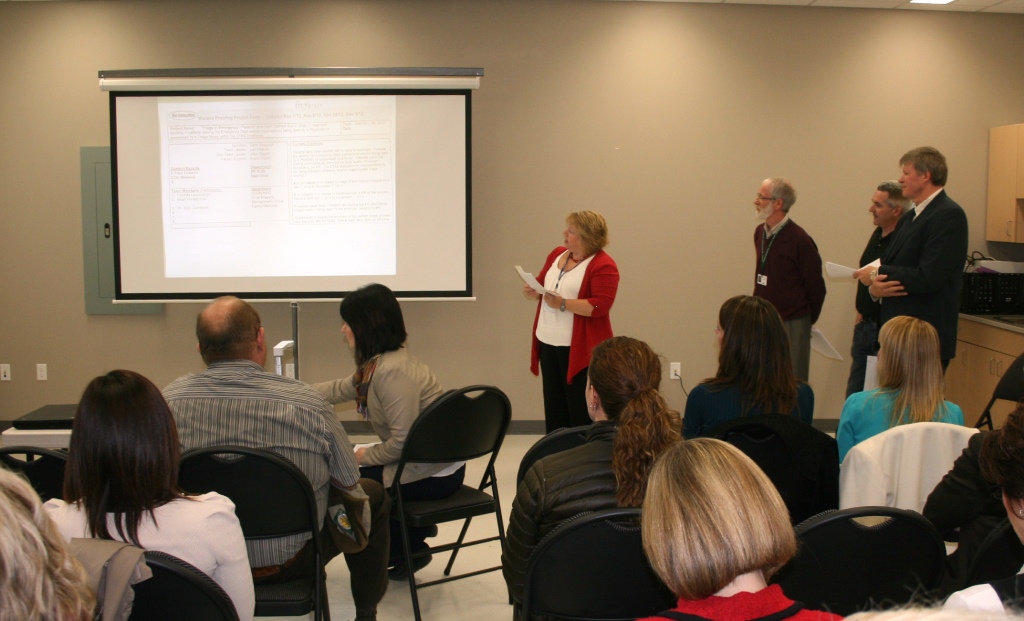Eliminating defects: Lori Friesen, Director of Pharmacy and Team Lead for the Emergency Department Triage team, begins the Report Out for the Mistake Proofing Project that looked at improving triage processes to reduce wait times.
Seeing how the use of tools can improve quality, safety and access for patients and clients has been an important step in the Prince Albert Parkland Health Region’s Lean journey. “I’m very pleased with the changes that have occurred as a result of the Rapid Process Improvement Workshop (RPIW),” said Gary Bridge, Manager of Forensics and Adults Services for the Community Mental Health Program. Prince Albert Parkland’s first RPIW was for the Community Mental Health Program. It was about reducing the time to schedule an appointment after the first referral. Data showed that it took between 6 to 16 days from the initial referral to when a client had an appointment scheduled. “It was, and continues to be, a lot of work to implement the new processes,” Bridge said. “The reward for us is seeing patients immediately receiving an appointment for services rather than having to wait, in distress, for so long.”
Keeping the focus on the patient, reducing wait times and other waste in the process, is the goal of Lean. Rapid Process Improvement Workshops are five-day events with a team focusing on very specific goals to achieve efficiencies and reduce waste. There have been seven RPIWs held in Prince Albert Parkland between March and July 2013. Much of the focus has been at the Victoria Hospital, particularly in the Emergency Department, Operating Room, Day Surgery and Ambulatory Care.
“When this new Lean work starting the staff had a difficult time believing it was not just the ‘flavor of the month’,” said Traci Hobson, Victoria Hospital Emergency Department Nursing Unit Manager. “Staff members had seen kaizens before where we had invested a lot of time and energy into an event only to have nothing changed at the end of the week. This thought is slowly changing, and they have confidence in how Lean is being used. They are seeing things being changed for the benefit of the patients and the staff.
Hobson said that having participants from all different areas gathering in the Emergency Department to try and improve things shows the extent of the dedication of the Region to improve the patient experience. She added that staff members also see that senior management is involved, both as participants on the teams, and as frequent visitors in the department to see the changes.
Another important aspect of the Lean work, especially the RPIW’s, is the involvement of patient representatives. “Having patient representatives on our team helps keep us focused on why we are doing this,” said Pat Stuart, Vice-President of Quality Management. “We always have a diverse team from across the Region that includes patients, and we are able to make a significant impact in a short period of time.”
Stuart said the Kaizen Promotion Office, which provides support for the Lean improvement work as well as providing and coordinating training for staff and physicians, is also evolving. “It has been a steep learning process for all of us, both in the KPO and all of our staff and physicians,” Stuart said. “We had to build the infrastructure to support the improvement work, and all of the individuals who are taking training. Our knowledge of how to use Lean tools has grown immensely.”
She said that a key learning has been the need to constantly be communicating with the programs involved in Lean work, including the managers, staff and physicians. “They need to be aware of what we the teams are, whether it is an RPIW, Kanban, Mistake Proofing, or 5S,” Stuart said. “Everyone needs to know where to get information on past events and future events and what this means to them, because continuous improvement is everybody’s job.”
Hobson said the Emergency Department staff who have been on different improvement teams have gained a lot of insight into what the other nurses work is in the hospital. “It has also given them opportunities to work with other nurses throughout the hospital and therefore bridging the gap that is present between other departments,” she said. “And having patient representatives on these teams working alongside the staff is invaluable. They keep the focus on the fact that what we are doing here is ultimately about improving things for our patients.”
The Community Mental Health RPIW made significant changes to their appointment scheduling processes, which required adjustments in how the clinical staff works, Bridge said. But the final results, while presenting some challenges, have been very satisfying.
“Staff are recognizing that in addition to the benefit to patients, with appointment times given directly from Intake, that they have also benefited by not having to spend so much of their day trying to contact patients to set appointment times,” Bridge said. “Since the RPIW, we have had numerous positive comments from clients who have been pleasantly surprised at how quickly they have received an appointment. Knowing your actual appointment date is very helpful to clients, as it allows for planning of the necessaries such as childcare, transportation and time off needed to attend.”
Seeing how the use of tools can improve quality, safety and access for patients and clients has been an important step in the Prince Albert Parkland Health Region’s Lean journey. “I’m very pleased with the changes that have occurred as a result of the Rapid Process Improvement Workshop (RPIW),” said Gary Bridge, Manager of Forensics and Adults Services for the Community Mental Health Program. Prince Albert Parkland’s first RPIW was for the Community Mental Health Program. It was about reducing the time to schedule an appointment after the first referral. Data showed that it took between 6 to 16 days from the initial referral to when a client had an appointment scheduled. “It was, and continues to be, a lot of work to implement the new processes,” Bridge said. “The reward for us is seeing patients immediately receiving an appointment for services rather than having to wait, in distress, for so long.”
Keeping the focus on the patient, reducing wait times and other waste in the process, is the goal of Lean. Rapid Process Improvement Workshops are five-day events with a team focusing on very specific goals to achieve efficiencies and reduce waste. There have been seven RPIWs held in Prince Albert Parkland between March and July 2013. Much of the focus has been at the Victoria Hospital, particularly in the Emergency Department, Operating Room, Day Surgery and Ambulatory Care.
“When this new Lean work starting the staff had a difficult time believing it was not just the ‘flavor of the month’,” said Traci Hobson, Victoria Hospital Emergency Department Nursing Unit Manager. “Staff members had seen kaizens before where we had invested a lot of time and energy into an event only to have nothing changed at the end of the week. This thought is slowly changing, and they have confidence in how Lean is being used. They are seeing things being changed for the benefit of the patients and the staff.
Hobson said that having participants from all different areas gathering in the Emergency Department to try and improve things shows the extent of the dedication of the Region to improve the patient experience. She added that staff members also see that senior management is involved, both as participants on the teams, and as frequent visitors in the department to see the changes.
Another important aspect of the Lean work, especially the RPIW’s, is the involvement of patient representatives. “Having patient representatives on our team helps keep us focused on why we are doing this,” said Pat Stuart, Vice-President of Quality Management. “We always have a diverse team from across the Region that includes patients, and we are able to make a significant impact in a short period of time.”
Stuart said the Kaizen Promotion Office, which provides support for the Lean improvement work as well as providing and coordinating training for staff and physicians, is also evolving. “It has been a steep learning process for all of us, both in the KPO and all of our staff and physicians,” Stuart said. “We had to build the infrastructure to support the improvement work, and all of the individuals who are taking training. Our knowledge of how to use Lean tools has grown immensely.”
She said that a key learning has been the need to constantly be communicating with the programs involved in Lean work, including the managers, staff and physicians. “They need to be aware of what we the teams are, whether it is an RPIW, Kanban, Mistake Proofing, or 5S,” Stuart said. “Everyone needs to know where to get information on past events and future events and what this means to them, because continuous improvement is everybody’s job.”
Hobson said the Emergency Department staff who have been on different improvement teams have gained a lot of insight into what the other nurses work is in the hospital. “It has also given them opportunities to work with other nurses throughout the hospital and therefore bridging the gap that is present between other departments,” she said. “And having patient representatives on these teams working alongside the staff is invaluable. They keep the focus on the fact that what we are doing here is ultimately about improving things for our patients.”
The Community Mental Health RPIW made significant changes to their appointment scheduling processes, which required adjustments in how the clinical staff works, Bridge said. But the final results, while presenting some challenges, have been very satisfying.
“Staff are recognizing that in addition to the benefit to patients, with appointment times given directly from Intake, that they have also benefited by not having to spend so much of their day trying to contact patients to set appointment times,” Bridge said. “Since the RPIW, we have had numerous positive comments from clients who have been pleasantly surprised at how quickly they have received an appointment. Knowing your actual appointment date is very helpful to clients, as it allows for planning of the necessaries such as childcare, transportation and time off needed to attend.”



